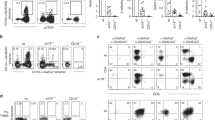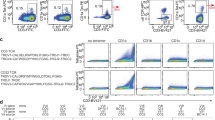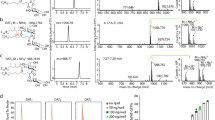Abstract
Natural killer T cells express a conserved, semi-invariant αβ T cell receptor that has specificity for self glycosphingolipids and microbial cell wall α-glycuronosylceramide antigens presented by CD1d molecules. Here we report the crystal structure of CD1d in complex with a short-chain synthetic variant of α-galactosylceramide at a resolution of 2.2 Å. This structure elucidates the basis for the high specificity of these microbial ligands and explains the restriction of the α-linkage as a unique pathogen-specific pattern-recognition motif. Comparison of the binding of altered lipid ligands to CD1d and T cell receptors suggested that the differential T helper type 1–like and T helper type 2–like properties of natural killer T cells may originate largely from differences in their 'loading' in different cell types and hence in their tissue distribution in vivo.
This is a preview of subscription content, access via your institution
Access options
Subscribe to this journal
Receive 12 print issues and online access
$209.00 per year
only $17.42 per issue
Buy this article
- Purchase on Springer Link
- Instant access to full article PDF
Prices may be subject to local taxes which are calculated during checkout







Similar content being viewed by others
References
Kronenberg, M. Toward an understanding of NKT cell biology: progress and paradoxes. Annu. Rev. Immunol. 23, 877–900 (2004).
Vincent, M.S. et al. CD1-dependent dendritic cell instruction. Nat. Immunol. 3, 1163–1168 (2002).
Zhou, D. et al. Lysosomal glycosphingolipid recognition by NKT cells. Science 306, 1786–1789 (2004).
Kinjo, Y. et al. Recognition of bacterial glycosphingolipids by natural killer T cells. Nature 434, 520–525 (2005).
Mattner, J. et al. Exogenous and endogenous glycolipid antigens activate NKT cells during microbial infections. Nature 434, 525–529 (2005).
Wu, D. et al. Bacterial glycolipids and analogs as antigens for CD1d-restricted NKT cells. Proc. Natl. Acad. Sci. USA 102, 1351–1356 (2005).
Bendelac, A., Bonneville, M. & Kearney, J.F. Autoreactivity by design: innate B and T lymphocytes. Nat. Rev. Immunol. 1, 177–186 (2001).
Fischer, K. et al. Mycobacterial phosphatidylinositol mannoside is a natural antigen for CD1d-restricted T cells. Proc. Natl. Acad. Sci. USA 101, 10685–10690 (2004).
Kawano, T. et al. CD1d-restricted and TCR-mediated activation of Va14 NKT cells by glycosylceramides. Science 278, 1626–1629 (1997).
Omae, F. et al. DES2 protein is responsible for phytoceramide biosynthesis in the mouse small intestine. Biochem. J. 379, 687–695 (2004).
Fujii, S., Shimizu, K., Smith, C., Bonifaz, L. & Steinman, R.M. Activation of natural killer T cells by α-galactosylceramide rapidly induces the full maturation of dendritic cells in vivo and thereby acts as an adjuvant for combined CD4 and CD8 T cell immunity to a coadministered protein. J. Exp. Med. 198, 267–279 (2003).
Hermans, I.F. et al. NKT cells enhance CD4+ and CD8+ T cell responses to soluble antigen in vivo through direct interaction with dendritic cells. J. Immunol. 171, 5140–5147 (2003).
Miyamoto, K., Miyake, S. & Yamamura, T. A synthetic glycolipid prevents autoimmune encephalomyelitis by inducing TH2 bias of natural killer T cells. Nature 413, 531–534 (2001).
Goff, R.D. et al. Effects of lipid chain lengths in α-galactosylceramides on cytokine release by natural killer T cells. J. Am. Chem. Soc. 126, 13602–13603 (2004).
Yu, K.O. et al. Modulation of CD1d-restricted NKT cell responses by using N-acyl variants of α-galactosylceramides. Proc. Natl. Acad. Sci. USA 102, 3383–3388 (2005).
Rudolph, M.G. et al. The crystal structures of K(bm1) and K(bm8) reveal that subtle changes in the peptide environment impact thermostability and alloreactivity. Immunity 14, 231–242 (2001).
Cantu, C., III, Benlagha, K., Savage, P.B., Bendelac, A. & Teyton, L. The paradox of immune molecular recognition of α-galactosylceramide: low affinity, low specificity for CD1d, high affinity for αβ TCRs. J. Immunol. 170, 4673–4682 (2003).
Zeng, Z. et al. Crystal structure of mouse CD1: An MHC-like fold with a large hydrophobic binding groove. Science 277, 339–345 (1997).
Zajonc, D.M., Elsliger, M.A., Teyton, L. & Wilson, I.A. Crystal structure of CD1a in complex with a sulfatide self antigen at a resolution of 2.15 Å. Nat. Immunol. 4, 808–815 (2003).
Moody, D.B., Zajonc, D.M. & Wilson, I.A. Anatomy of CD1-lipid antigen complexes. Nat. Rev. Immunol. 5, 387–399 (2005).
Gadola, S.D. et al. Structure of human CD1b with bound ligands at 2.3 Å, a maze for alkyl chains. Nat. Immunol. 3, 721–726 (2002).
Batuwangala, T. et al. The crystal structure of human CD1b with a bound bacterial glycolipid. J. Immunol. 172, 2382–2388 (2004).
Scott, C.A., Garcia, K.C., Carbone, F.R., Wilson, I.A. & Teyton, L. Role of chain pairing for the production of functional soluble I-A major histocompatibility complex class II molecules. J. Exp. Med. 183, 2087–2095 (1996).
Apostolopoulos, V. et al. Crystal structure of a non-canonical high affinity peptide complexed with MHC class I: a novel use of alternative anchors. J. Mol. Biol. 318, 1307–1316 (2002).
Zajonc, D.M. et al. Molecular mechanism of lipopeptide presentation by CD1a. Immunity 22, 209–219 (2005).
Brossay, L. et al. Structural requirements for galactosylceramide recognition by CD1-restricted NK T cells. J. Immunol. 161, 5124–5128 (1998).
Burdin, N. et al. Structural requirements for antigen presentation by mouse CD1. Proc. Natl. Acad. Sci. USA 97, 10156–10161 (2000).
Sidobre, S. et al. The Vα14 NKT cell TCR exhibits high-affinity binding to a glycolipid/CD1d complex. J. Immunol. 169, 1340–1348 (2002).
Sidobre, S. et al. The T cell antigen receptor expressed by Vα14i NKT cells has a unique mode of glycosphingolipid antigen recognition. Proc. Natl. Acad. Sci. USA 101, 12254–12259 (2004).
Stanic, A.K. et al. Defective presentation of the CD1d1-restricted natural Vα14Jα18 NKT lymphocyte antigen caused by β-D-glucosylceramide synthase deficiency. Proc. Natl. Acad. Sci. USA 100, 1849–1854 (2003).
Parekh, V.V. et al. Quantitative and qualitative differences in the in vivo response of NKT cells to distinct α- and β-anomeric glycolipids. J. Immunol. 173, 3693–3706 (2004).
Ortaldo, J.R. et al. Dissociation of NKT stimulation, cytokine induction, and NK activation in vivo by the use of distinct TCR-binding ceramides. J. Immunol. 172, 943–953 (2004).
Koch, M. et al. The crystal structure of human CD1d with and without α-galactosylceramide. Nat. Immunol. advance online publication 10 July 2005 (10.1038/ni1225).
Speir, J.A. et al. Structural basis of 2C TCR allorecognition of H-2Ld peptide complexes. Immunity 8, 553–562 (1998).
Wu, D.Y., Segal, N.H., Sidobre, S., Kronenberg, M. & Chapman, P.B. Cross-presentation of disialoganglioside GD3 to natural killer T cells. J. Exp. Med. 198, 173–181 (2003).
Amprey, J.L. et al. A subset of liver NK T cells is activated during Leishmania donovani infection by CD1d-bound lipophosphoglycan. J. Exp. Med. 200, 895–904 (2004).
Zhou, D. et al. Editing of CD1d-bound lipid antigens by endosomal lipid transfer proteins. Science 303, 523–527 (2004).
Van Rhijn, I. et al. CD1d-restricted T cell activation by nonlipidic small molecules. Proc. Natl. Acad. Sci. USA 101, 13578–13583 (2004).
Lantz, O. & Bendelac, A. An invariant T cell receptor α chain is used by a unique subset of major histocompatibility complex class I-specific CD4+ and CD4−8− T cells in mice and humans. J. Exp. Med. 180, 1097–1106 (1994).
Apostolou, I., Cumano, A., Gachelin, G. & Kourilsky, P. Evidence for two subgroups of CD4−CD8− NKT cells with distinct TCR αβ repertoires and differential distribution in lymphoid tissues. J. Immunol. 165, 2481–2490 (2000).
Garcia, K.C., Teyton, L. & Wilson, I.A. Structural basis of T cell recognition. Annu. Rev. Immunol. 17, 369–397 (1999).
Wu, L.C., Tuot, D.S., Lyons, D.S., Garcia, K.C. & Davis, M.M. Two-step binding mechanism for T-cell receptor recognition of peptide MHC. Nature 418, 552–556 (2002).
Piel, J. et al. Antitumor polyketide biosynthesis by an uncultivated bacterial symbiont of the marine sponge Theonella swinhoei. Proc. Natl. Acad. Sci. USA 101, 16222–16227 (2004).
Bezbradica, J.S. et al. Distinct roles of dendritic cells and B cells in Vα14Jα18 natural T cell activation in vivo. J. Immunol. 174, 4696–4705 (2005).
Moody, D.B., Besra, G.S., Wilson, I.A. & Porcelli, S.A. The molecular basis of CD1-mediated presentation of lipid antigens. Immunol. Rev. 172, 285–296 (1999).
Benlagha, K., Weiss, A., Beavis, A., Teyton, L. & Bendelac, A. In vivo identification of glycolipid antigen-specific T cells using fluorescent CD1d tetramers. J. Exp. Med. 191, 1895–1903 (2000).
Otwinowski, Z. & Minor, W. HKL: Processing of X-ray diffraction data collected in oscillation mode. Methods Enzymol. 276, 307–326 (1997).
Vagin, A.A. & Teplyakov, A. MOLREP: an automated program for molecular replacement. J. Appl. Cryst. 30, 1022–1025 (1997).
Murshudov, G.N., Vagin, A.A. & Dodson, E.J. Refinement of macromolecular structures by the maximum likelihood method. Acta Crystallogr. D53, 240–255 (1997).
Jones, T.A., Zou, J.Y., Cowan, S. & Kjeldgaard, M. Improved methods for building protein models in electron density maps and the location of errors in these models. Acta Crystallogr. A47, 110–119 (1991).
Schuttelkopf, A.W. & van Aalten, D.M. PRODRG: a tool for high-throughput crystallography of protein-ligand complexes. Acta Crystallogr. D60, 1355–1363 (2004).
Kleywegt, G.J. & Jones, T.A. Homo crystallographicus–quo vadis?. Structure (Camb) 10, 465–472 (2002).
Stanfield, R.L., Ghiara, J.B., Ollmann Saphire, E., Profy, A.T. & Wilson, I.A. Recurring conformation of the human immunodeficiency virus type 1 gp120 V3 loop. Virology 315, 159–173 (2003).
Lovell, S.C. et al. Structure validation by Cα geometry: ψ,φ and Cβ deviation. Proteins 50, 437–450 (2003).
DeLano, W. The PyMOL Molecular Graphics System. http://www.pymol.org. (2002).
Kraulis, P.J. MOLSCRIPT: a program to produce both detailed and schematic plots of protein structures J. Appl. Crystallogr. 24, 946–950 (1991).
Baker, N.A., Sept, D., Joseph, S., Holst, M.J. & McCammon, J.A. Electrostatics of nanosystems: application to microtubules and the ribosome. Proc. Natl. Acad. Sci. USA 98, 10037–10041 (2001).
Merritt, E.A. & Bacon, D.J. Raster3D: photorealistic molecular graphics. Methods Enzymol. 277, 505–524 (1997).
Jahng, A. et al. Prevention of autoimmunity by targeting a distinct, noninvariant CD1d-reactive T cell population reactive to sulfatide. J. Exp. Med. 199, 947–957 (2004).
CCP4. Collaborative Computational Project, Number 4. The CCP4 suite: programs for protein crystallography. Acta Crystallogr. D50, 760–763 (1994).
Kamada, N. et al. Crucial amino acid residues of mouse CD1d for glycolipid ligand presentation to Vα14 NKT cells. Int. Immunol. 13, 853–861 (2001).
Acknowledgements
We thank the staff of the Advanced Light Source BL 8.2.2 for support with data collection; P. Wright and L. Tennant for help with the circular dichroism experiments; and R. Stanfield for help with data analysis. Supported by the National Institutes of Health (AI053725 to L.T., A.B. and P.B.S.; GM62116 and CA58896 to I.A.W.), Skaggs Institute for Chemical Biology (D.M.Z. and I.A.W.) and Cancer Research Institute (J.M.).
Author information
Authors and Affiliations
Corresponding authors
Ethics declarations
Competing interests
The authors declare no competing financial interests.
Rights and permissions
About this article
Cite this article
Zajonc, D., Cantu, C., Mattner, J. et al. Structure and function of a potent agonist for the semi-invariant natural killer T cell receptor. Nat Immunol 6, 810–818 (2005). https://doi.org/10.1038/ni1224
Received:
Accepted:
Published:
Issue Date:
DOI: https://doi.org/10.1038/ni1224
This article is cited by
-
A guide to antigen processing and presentation
Nature Reviews Immunology (2022)
-
What one lipid giveth, another taketh away
Nature Immunology (2019)
-
Induction of specific adaptive immune responses by immunization with newly designed artificial glycosphingolipids
Scientific Reports (2019)
-
Control of CD1d-restricted antigen presentation and inflammation by sphingomyelin
Nature Immunology (2019)
-
T cell autoreactivity directed toward CD1c itself rather than toward carried self lipids
Nature Immunology (2018)



